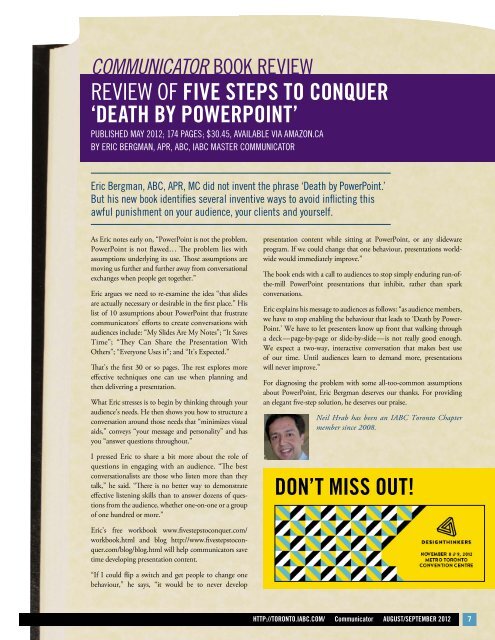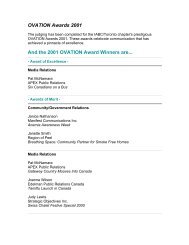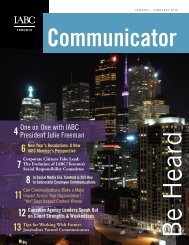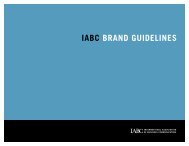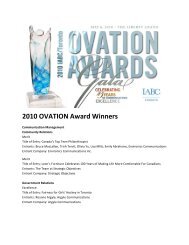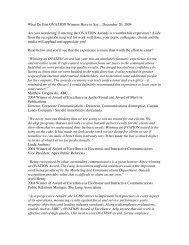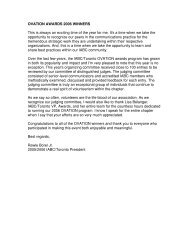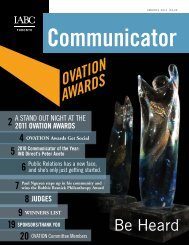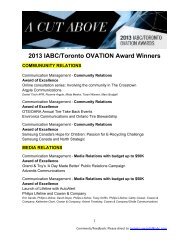Communicator
CommuniCator - IABC/Toronto
CommuniCator - IABC/Toronto
- No tags were found...
Create successful ePaper yourself
Turn your PDF publications into a flip-book with our unique Google optimized e-Paper software.
<strong>Communicator</strong> book review<br />
REVIEW OF FIVE STEPS TO CONQUER<br />
‘DEATH BY POWERPOINT’<br />
Published May 2012; 174 pages; $30.45, available via Amazon.ca<br />
By Eric Bergman, APR, ABC, IABC Master <strong>Communicator</strong><br />
Eric Bergman, ABC, APR, MC did not invent the phrase ‘Death by PowerPoint.’<br />
But his new book identifies several inventive ways to avoid inflicting this<br />
awful punishment on your audience, your clients and yourself.<br />
As Eric notes early on, “PowerPoint is not the problem.<br />
PowerPoint is not flawed… The problem lies with<br />
assumptions underlying its use. Those assumptions are<br />
moving us further and further away from conversational<br />
exchanges when people get together.”<br />
Eric argues we need to re-examine the idea “that slides<br />
are actually necessary or desirable in the first place.” His<br />
list of 10 assumptions about PowerPoint that frustrate<br />
communicators’ efforts to create conversations with<br />
audiences include: “My Slides Are My Notes”; “It Saves<br />
Time”; “They Can Share the Presentation With<br />
Others”; “Everyone Uses it”; and “It’s Expected.”<br />
That’s the first 30 or so pages. The rest explores more<br />
effective techniques one can use when planning and<br />
then delivering a presentation.<br />
What Eric stresses is to begin by thinking through your<br />
audience’s needs. He then shows you how to structure a<br />
conversation around those needs that “minimizes visual<br />
aids,” conveys “your message and personality” and has<br />
you “answer questions throughout.”<br />
I pressed Eric to share a bit more about the role of<br />
questions in engaging with an audience. “The best<br />
conversationalists are those who listen more than they<br />
talk,” he said. “There is no better way to demonstrate<br />
effective listening skills than to answer dozens of questions<br />
from the audience, whether one-on-one or a group<br />
of one hundred or more.”<br />
presentation content while sitting at PowerPoint, or any slideware<br />
program. If we could change that one behaviour, presentations worldwide<br />
would immediately improve.”<br />
The book ends with a call to audiences to stop simply enduring run-ofthe-mill<br />
PowerPoint presentations that inhibit, rather than spark<br />
conversations.<br />
Eric explains his message to audiences as follows: “as audience members,<br />
we have to stop enabling the behaviour that leads to ‘Death by Power-<br />
Point.’ We have to let presenters know up front that walking through<br />
a deck—page-by-page or slide-by-slide—is not really good enough.<br />
We expect a two-way, interactive conversation that makes best use<br />
of our time. Until audiences learn to demand more, presentations<br />
will never improve.”<br />
For diagnosing the problem with some all-too-common assumptions<br />
about PowerPoint, Eric Bergman deserves our thanks. For providing<br />
an elegant five-step solution, he deserves our praise.<br />
Neil Hrab has been an IABC Toronto Chapter<br />
member since 2008.<br />
DON’T MISS OUT!<br />
Eric’s free workbook www.fivestepstoconquer.com/<br />
workbook.html and blog http://www.fivestepstoconquer.com/blog/blog.html<br />
will help communicators save<br />
time developing presentation content.<br />
“If I could flip a switch and get people to change one<br />
behaviour,” he says, “it would be to never develop<br />
http://toronto.iabc.com/ <strong>Communicator</strong> AUGUST/SEPTEMBER 2012 7


